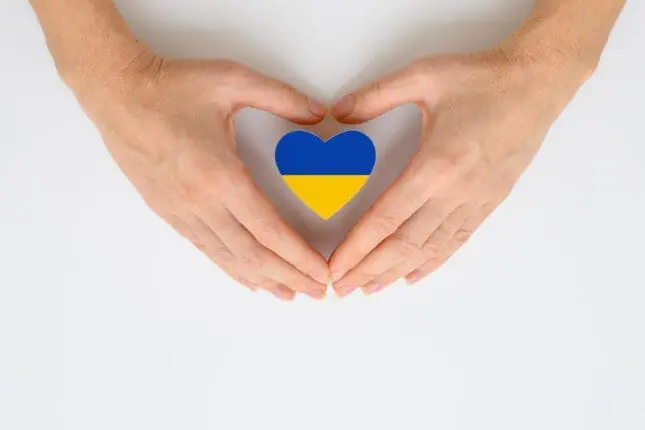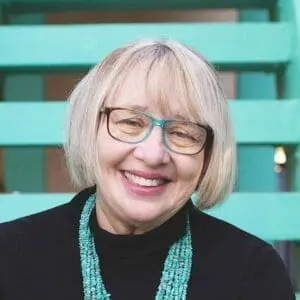On March 1, 2022, an anguished voice begins, “My name is Marianna. My house is destroyed. My office is being shelled. I have barely escaped with my life.” She’s shakily accessing a video call from her location in Ukraine, but her image doesn’t appear on the screen, only her voice can be heard. “I will never be the same again,” she says to the Ukranian and international teachers, parents, grandparents, community members, and trauma specialists on the screen. “I will never experience happiness or laughter again.”
As we listen, Marianna tells us how alone she feels in her despair. “I am with my family, but cannot share my feelings,” she explains.
“We can be here for you in this moment,” I tell her. “Can you sense that you are not alone now?”
She pauses, then tells us more about the trauma she’s living through. “I’m alive now, but tomorrow they could kill me.” She speaks about the depersonalization of war and the surreal way that she’s detaching from the horror surrounding her so that she can get through each minute. Her voice rises, full of grief. “I’ve never done anything to the Russian people!” she insists.
I begin to talk to her and the others on the call about moral injury and how difficult it is when our values about how to treat others are violated in war. Then I invite Marianna to use a community resilience, strength-based skill of bringing awareness to her internal and external sources of support and strength. She goes quiet, and after a moment, says, “I am crying now. The group is helping.”
“We are embracing you,” I assure her. The others on the call nod compassionately. I ask her if she can sense and hold compassion for herself and for others at this moment. “Yes,” she murmurs.
“Now that I can feel my tears, I’m thankful for them. It means I’m alive. But I’m actually ready to die for my country,” she tells us, with surprise in her voice. “It’s the most honorable thing a person can do.”
The other Ukrainians on the call begin to speak up with poignant statements of encouragement. They affirm her courage, her wisdom for sharing her anguish, her tears, and her happiness for tears.
The call is nearly over and Marianna closes by saying, “This is a safe space. I thank you.”
Providing Trauma Support While It’s Happening
Our mission at The Trauma Resource Institute (TRI) has always been to provide healing strategies to people of all ages in the aftermath of human-made and natural disasters. I’ve personally worked with refugees and traumatized communities following natural disasters, armed conflict, and mass shootings: in Haiti, China, Nepal, Thailand, Northern Ireland, Mexico, India, Turkey, parts of Africa, and many areas of the U.S. Our international cadre of Community Resiliency Model teachers bring six wellness skills to bear that can reset the nervous system and positively impact depression, anxiety, PTSD, secondary traumatic stress, and resilience.
We provide empathy and support by helping people focus on bringing the body back into homeostasis and out of hyper- or hypoarousal. We explain the biology of survival responses and how to regulate the body’s responses when they are in “safer” situations. And we implement a strengths-based perspective to remind people of their courage and internal resources. Without minimizing the difficulties they’re experiencing, we also teach basic thought-stopping techniques.
As images of the Russian invasion of Ukraine besieged social and traditional media, many of us were shocked at the violence and destruction, and wondered how we could help. At TRI, we are used to offering support after a trauma, but we wondered now if could we find a way to share our interventions with affected people during the trauma. If so, it would be a paradigm shift in how our organization could respond to human suffering.
Since the Fall of 2019, when I was invited to speak at their national educational conference, TRI has had a strong relationship with EdCamp Ukraine, an organization that focuses on improving the Ukrainian education system through career-enhancement training and lobbying for educational reforms. Our colleagues at EdCamp had asked for a Community Resiliency Model workshop to be taught to educators around the country via Zoom and streaming on Facebook, which we’d become adept at doing during the pandemic. Thus, TRI’s Ukrainian Humanitarian Resiliency Project was born.
Now, with the ability to successfully reach Ukrainians online, we realized we didn’t have to wait for conflict to end to be of help. And we’d be able to help many more people, in real time, than we would’ve been able to if responding in person.
In about 24 hours, we were able to adapt our workshop, based on our Community Resiliency Model, translate our materials into Ukrainian, and launch a series of four webinars that began in late February. Citizens from all over the Ukraine joined us—while their neighborhoods were being shelled, after friends and family were killed, from underground shelters, and in the midst of fleeing to safer spaces.
When these workshops ended, our Ukrainian colleagues then requested daily meetings to reinforce the skills of the Community Resiliency Model and respond to questions. As of this writing, these 40 or so days of daily meetings have provided direct support as well as illuminated the wisdom and courage of the Ukrainian people. The meetings are offered live, and the recordings posted on the EdCamp Ukraine Facebook page for any that miss them, resulting in close to 50,000 views.
The webinars and support meetings are staffed by employees of TRI and volunteers (psychologists, social workers, marriage and family therapists, and natural leaders) who’ve been trained in our Community Resiliency Model. Many of them are trauma therapists trained in somatic-based models like the Trauma Resiliency Model and Somatic Experiencing as well as EMDR, cognitive therapy, trauma-focused yoga and crisis intervention. Staff from EdCamp Ukraine are present for every offering. All webinars and support meetings are translated in real time into Ukrainian by volunteer translators.
What Those on the Ground are Feeling
We’ve received questions from the Ukrainians about suicidal thoughts, panic attacks, losing faith, grief, fears of rape and torture, being plagued by the sounds and images of killing, the fear of being killed, and fear for the well-being of loved others. We’ve addressed many questions about safeguarding the mental health of children and adolescents. There’ve also been many questions about how to support loved ones at the front.
As the war has raged on, we’ve heard more expressions of hopelessness and of the omnipresence of fear. But there has also been dialogue about the future–discussions about what people will need when Ukraine begins to build back after the war.
It’s not been uncommon for participants like Anna to express a mix both suffering and strength: “My family has survived World War I, World War II, and the great famine,” she shared. “I did not believe my generation would experience war, but now I know I’ll survive the Russian War. Ukrainian DNA is strong, and I will give this strength to my daughter, and she will give it to her children.”
Unlike posttraumatic work, the experience of providing aid this way means new traumas are ever present. During our calls, we’ve heard the warning sirens of imminent shellings and seen our participants faces twist in terror as bombs explode in their neighborhoods. Our staff and volunteers are vulnerable to not knowing if the Ukrainians they meet with or hear about will survive, be tortured, or die.
Those of us doing this work outside of Ukraine, have had the discomfiting experience of being in the “bubble of war” for two hours a day and then pivoting back to our lives of relative calm. The wake of the meetings stay with us so we have daily support meetings for staff and volunteers to process their feelings and reactions.
Threads of Hope
Those of us doing this work from outside the warzone realize our efforts come from a place of advantage and safety, and we’re humbled by the wisdom of the lived experiences of our Ukrainians colleagues. Although hope during war can be fleeting, we were heartened when, during one of our meetings in March, the Ukrainians asked if anyone wanted to share a song after a discussion of the healing qualities of music.
After a pause, a sweet, acapella voice gained strength and sang a Ukrainian hymn. There were tears of gratitude in the eyes of the fellow participants, and when the singer finished her hymn, we discovered it was Marianna. She said she was starting to feel differently than she had earlier in the month. In fact, she’d been able to sleep and eat more than a few bites that day for the first time since the war had started. Friends had even managed to locate and give her some flowers. “It was like a miracle,” she told us, to find this hope inside herself during the war.
Marianna’s suffering and courage mirror that of many Ukranians we’re working with who’ve also found and expressed their own fibers of hope. To hear or see what they’re seeing, we’ve made past webinars and daily support meetings available at EdCamp Ukraine Facebook, or you can contact the Trauma Resource Institute for more information at traumaresourceinstitute.com.
Photo © iStock/Nikita Burdenov
Watch senior writer Lauren Dockett talk with Elaine about her trauma resources for wartime victims.
Elaine Miller-Karas
Elaine Miller-Karas, MSW, LCSW, is a trauma therapist, lecturer, cofounder, and Director of Innovation at the Trauma Resource Institute, and founding member of the International Transformational Resilience Coalition. The author of Building Resiliency to Trauma: The Trauma and Community Resiliency Models, she’s a key developer of the Trauma Resiliency and Community Resiliency Models. Her radio talk show Resiliency Within: Building Resiliency During Unprecedented Times can be found on VoiceAmerica.













